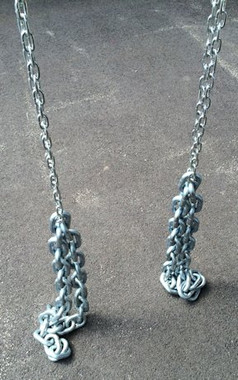Description
|
||||||||||||||||||||||||||||||||
Connecting (small) chains slide over the ends of the bar. As you lift, the weight of the chain progressively increases as more and more chain lifts off the floor. The weight you are lifting progressively becomes heavier, providing maximum muscular stimulation throughout the entire range of motion

A "set" consists of two large chains, two small connecting chains and two quick links.
You get added versatility with two extra long, 3/16 x 72" attaching chains. The extra length allows you to adjust up to a full standing length of 8 feet or adjust as short as you prefer. The attaching chain goes thru any link in the larger chain and connects to form a complete loop that slips over the ends of the bar.

Thread the attaching chain through the end link for standing lifts or in the middle of the chain (pictured) to shorten the assembly for incline or bench press.
Connecting (small) chains slide over the ends of the bar. As you lift, the weight of the chain progressively increases as more and more chain lifts off the floor. The weight you are lifting progressively becomes heavier, providing maximum muscular stimulation throughout the entire range of motion.
We do not carry clamping collars - besides being stupidly expensive, they defeat the purpose of progressive resistance. From Louie Simmons "Attach the chains to the bar with a lightweight chain to adjust where the heavy chain will leave the floor and contribute to the weight on the bar." He suggests that half the chain should be on the floor when racked and, as you lift, the load of the chain gets heavier as it coils off the floor until all the chain is off the floor at full extension. Using a clamping collar will take all five feet of chain off the ground when racked thus no progression.







